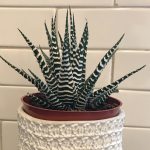Have you ever been watering your houseplants only to see a spray of little grey flies jump up from the soil? You likely have a crop of fungus gnats. Fungus gnats are not particularly harmful to houseplants, but they are still a pest so if you discover you have fungus gnats in your plants you should do your best to eradicate them quickly.In this blog, let’s talk about how to identify fungus gnats, where fungus gnats come from, how fungus gnats affect your plants and how to control fungus gnats.
How to Identify Fungus Gnats
The first clue that you have Fungus Gnats in your houseplants is by a typical spray of little black flies that jump up when you water your houseplants. Fungus Gnats are particularly attracted to pots with leafy plants and flowering plants. Some of their faves are African Violets, Geraniums, and Poinsettias.Plant clues that you may have Fungus Gnats are yellowed, wilting, and dropping leaves near the base of the plant and plant growth has slowed down significantly over time. This happens when the infestation is well advanced and root damage has occurred from a high population of larvae that has affected the plant’s vigor and vitality.
Where Do Fungus Gnats Develop?
Fungus gnats develop, grow, and hang out on the very top layers of soil. Fungus gnats feed on fungus and other decaying organic matter that occur in moist soils. Soils that contain peat moss are particularly attractive to fungus gnats, and most potting soils do have a peat moss component because peat moss makes a great base for potting soil.
Peat moss itself is decaying organic matter and fungus gnats and their larvae are a natural part of the decomposition process of peat moss. The larvae pupate into flying gnats. You don’t normally notice that the gnats are present until you water – the water flow disturbs them, so they fly up to get out of the way.
Fungus Gnats do live outdoors, too, but we usually don’t notice them and other insects feed on them. When the cool days of fall approach, fungus gnats seek warmer territory and can migrate into homes. Once indoors, there are no predators to consume them.
Fungus Gnats are harmless to humans – they don’t bite, sting, attack buildings or other structures. For the most part, their effect is innocuous and asymptomatic to plants.
Identifying the Life Stages of a Fungus Gnat
You can see each life stage of the fungus gnat with the naked eye, but they are small. Each life stage of a Fungus Gnat has its own unique characteristics

- Fungus Gnat Larvae have translucent white bodies measuring 5 cm long white black heads (gross!).
- Fungus Gnat Eggs are tiny & round in shape and are a translucent white colour.
The Life Cycle of a Fungus Gnat

Fungus gnats develop from egg to adult in about 14-21 days. Here’s how the cycle is split up: please use the darkwinged fungus gnat 3 stages photo for this one here
- 5 days are needed to hatch after the egg has been laid.
- Another 5-7 days are needed to pupate from larvae to adults inside or on top of the soil.
- The larvae feed on decomposing materials and will also feed on exposed roots.
- The adults are weak flyers, so that is why you see them hopping about when they have been disturbed.
- They live about 5 more days as adults.
- Females can lay up to 200 eggs in the top layers of the potting soil in nooks and crannies.
How to Control Fungus Gnats
Fungus Gnats can be a little tricky to get rid of once you have them, consistency is the key to batting down their populations. Finding a way to prevent them in the first place is always better and we’ll look at ways to do that too.
Check out the following options for controlling fungus gnats & pick the one that is best for you:
1. Using sterile or pasteurized potting soil will decrease fungus gnats.
This is a great first step in preventing a Fungus Gnat population altogether. Because their eggs and larvae naturally occur in peat moss, which is most often a base for potting soils, the sterilization process should kill both the larvae and the eggs even before you plant anything.
2. Inspect house plants for Fungus Gnats before you take them home:
Before you take any plant home with you — whether that’s purchasing them from a store, greenhouse, garden center, or accepting them from a friend — take a good look at the plant’s stem and the top of the soil for adult gnats or larvae. Rub the soil a little with your finger and tap the stem where it meets the soil.
If you ever give your houseplants a vacation outdoors for the summer, check them well before you bring them back indoors.
3. Decrease Fungus Gnat Populations by Reducing Soil Moisture Levels
Moisture is a Fungus Gnat’s best friend, wet soil is their happy place and they will live where the water is because that is where the food is. Fungi loves a good drink, so diminishing soil moisture will interfere with the gnat’s life cycle.
Here are some ways to decrease soil moisture:
- Avoid overwatering – check soil moisture before watering and allow the soil to dry out between waterings to decrease the growth of fungus.
- Check that the pots are draining properly. Houseplants require less water than plants growing outdoors because there is less air movement and the temperatures are more even indoors.
- Adding ½ cm of sand on top of the potting soil will help keep the top layer stay dry.
- A thin layer of diatomaceous earth placed on top of the soil will help decrease populations, too, because diatomaceous earth is rough and sharp, causing abrasions on the soft larvae bodies.
4. Re-pot a Plant that has Fungus Gnats
You can give the whole plant a redo by completely changing out the soil. Here’s how:
- Clean all soil off the roots well and wash them clean with clear water.
- If you’d like to use the same pot, wash it with hot soapy water and dry it well.
- Again, use sterile potting soil to replant.
5. Use a Hydrogen Peroxide / Water Solution to Kill Fungus Gnat Larvae
Hydrogen Peroxide kills Fungus Gnat larvae on contact. Here are the instructions for using hydrogen peroxide:
- Mix up a 25% solution: 1 part hydrogen peroxide to 3 parts water, and spray it on the top layer of the soil, where most of the larvae dwell.
- If you’d like, disturb the soil a bit and spray again.
6. Use Yellow Sticky Traps to Catch Adult Fungus Gnats

Yellow sticky traps are a great chemical free option. They attract and catch the adult flies so they can’t lay any eggs.
- Attach sticky traps to some kind of a stick – a popsicle stick or tongue depressor will work – with 5-7 cm (2-3″) of the stick left bare to push into the soil.
- Let the sticky trap stand 2cm (.5″) above the soil and watch it do it’s magic!
7. Use Thin Slices of Potato to Attract Fungus Gnat Larvae
The University of Manitoba suggests placing thin slices or strips of potato on top of soil to attract larvae.
- Give it about 48 hours and you should find some larvae there. Discard the potato and repeat as necessary.
8. The Use of Insecticides for Controlling Fungus Gnat
Insecticidal drenches or systemics are a final approach when all avenues have been exhausted. Follow package directions carefully.
In Conclusion
Remember to keep a watchful eye on your indoor plants regularly, changes happen quietly and insidiously. Fungus Gnat infections can be controlled with consistent, persistent effort.
Feel free to contact me with any questions you have or any ideas that you would like to add to this discussion – your feedback is always appreciated & valued.
©Sharon Wallish Murphy, Gardening with Sharon








